|
- Catalog (in stock)
- Back-Catalog
- Mail Order
- Online Order
- Sounds
- Instruments
- Projects
- History Face
- ten years 87-97
- Review Face
- our friends
- Albis Face
- Albis - Photos
- Albis Work
- Links
- Home
- Contact
- Profil YouTube
- Overton Network
P & C December 1998
- Face Music / Albi
- last update 03-2016
|
1. Shaman dance - traditional dance of the Siberian shamans - 4:37
2. Chatkhan oiyny - traditional chatkhan melody of the Khakass people - 4:07
3. Alyptyg nymakh - epos about the world creation, version of the Khakass poeple - 4:47
4. Topshuurym - my topshur - epos of the topshure, version of the Altai people - 9:22
5. Chir - the earth - traditional melody of the Khakass people - 3:41
6. Altyn tuu - the golden mountain - traditional song of the Altai people - 4:32
7. Shor saryn - traditional song in the shor dialect of the Khakass people - 3:45
8. An'chy - hunter's dance - traditional dance of the Khakass people - 2:07
9. Irlik's dance - dance of the Siberian spirits of evil - traditional dance, version of Khakass people - 2:28
10. Emildin kozhongy - song of Emil - traditional song of the Altai people - 6:00
11. Ulu chöl - the great steppe - traditional song of the Altai people - 2:35
12. Argymak - the race horse - traditional song of the Altai people - 3:22
13. Arzhan - the sacred water spring - traditional chatkhan melody of the Khakass people - 1:57
14. Adangar chiri - the land of the fathers - traditional song of the Khakass people - 3:57
15. Salkhyn - the song of the wind - traditional melody for khomys and topshur of the Altai people - 2:19
16. Algystyg saryn - traditional song of the Khakass people - 4:32
17. Oi-oiym - traditonal song of the Altai people - 5:52
Üch Sümer - is the second highest mountain of Russia (its absolute height 4'506m) and situated in the Ust-Koksa aimak (district) of the Altai Republic, which shares international borders with China, Mongolia and Kazakhstan. The Altai Republic is located in the vast Altai mountain range which extends into these three countries and therefore offers a beautiful panorama which extends into these gorgeous mountains. Üch Sümer is also well seen from the Kazakhstan side. This sacred mountain Üch Sümer ("three peaks"), an object of special reference for the indigenous people is also called "Kadyn Bazhy" ("Top of the Katun River") in the Altai language. It is also known as "Belukha" ("white"), a white ice cap covers it and that might explain the origin of the Russian name of the mountain. In the Buddhist legends one can find references to a sacred mountain Sümeru which is located elsewhere unknown in Central Asia but this promised land (also known as Sambhala or Shangri-la) is accessible only for spiritually developed people.
In the name of the ensemble "Üch Süme-R" we have a play of words (the name of the sacred mountain and two more semantic meanings). The words "üch süme" mean "three wisdom" or "three pieces of wisdom", at the same time semantic meanings of the words are "three souls" (="three men") as in the Altai language "süme" also means "soul", "spirit".
The Ensemble Üch-Süme-R (means three peaks) was founded in November 2000 and participated in the International Festival "Delphic Games" 2000 in Moscow and in the International Ethnic Festival "Zhivaya Voda" 2001 in Altyn-Köl (Teletskoye ozero - Golden lake) in Altai.
- Text by Chagat Almashev -
The repertoire of this ensemble comprises traditional folk songs from Khakassia and the Altai as well as the musicians' own songs.
The ensemble recorded their first album "Kadyn Bazhy" (Belukha - means white mountain) in February 2001 in Abakan (means the Bear's Blood), Khakassia.
Since February 2001 the three musicians have been working with the Khakassian Puppet Theatre "Skazka" and performed within the "Altyn Ayakh" projects. They won together a prize at the theatre Festival "Kontakt-2001" in Torun, Poland and at the 4th International Festival of Puppet Art "Spectaculo Interesse" in the Czech Republic.
The Turkic peoples in Khakassia and in the Altai region were hunters and nomadic shepherds tending sheep, horses and sometimes camels. They bequeathed an extremely interesting culture to their descendants, the basic features which have been handed down from ancient times until the present day. One of the most important forms of Khakass and Altai art is the narration of epics in a falsetto voice to the accompaniment of the two-string lute khomys (topshur). In Khakassia they were also accompanied by chatkhan (jadagan) or rare yykh (ikili). Texts are usually enunciated in a low guttural bass register used by throat singers (khaigee).
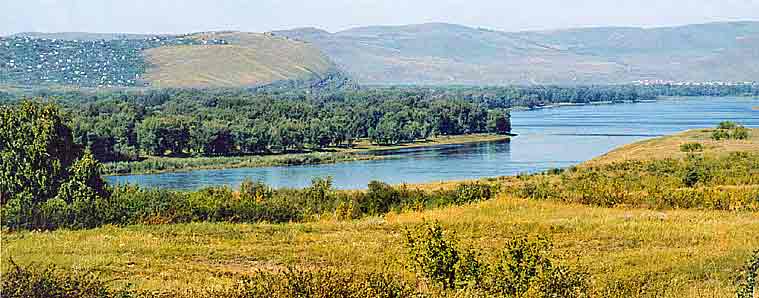
Khakassia: River Abakan - Bear's blood
Songs
1. Shaman dance - traditional dance of the Siberian shamans
- Erturk: voice (throat singing in khai, sygyt, koomoi), tuur (tungur), Emil: voice (throat singing in khai, sygyt, koomoi), Toma: bell
|
2. Chatkhan oiyny - traditional chatkhan melody of the Khakass people
- Toma: chatkhan (jadagan) solo
|
3. Alyptyg nymakh - epos about the world creation, version of the Khakass people
- Toma: voice, chatkhan (jadagan), Emil: voice (throat singing in sygyt, koomoi style), Erturk: voice (throat singing in khai style)
|
In the beginning, only water, the sun and the moon existed. There was a Lord who felt lonely and created another Lord. Together they made the earth and the mountains. They had a quarrel later. The first Lord's name was Tchayan (Ulgen), the God of Heaven and the other Lord's name was Irlik-Khan (Erlik), the master of the underworld. Tchayan created eight men, one with the name Maidere, the Khan of the people. He created the first women. She brought knowledge, love and mistake.
There are many versions of this Altaic creation story in which is the evil, Erlik and the God Ulgen. He has created the earth. In this story, the eighth man, named Maidere, he must bring the breath of life from God to the first woman. Every tribe has his own.
|
- Myth of Creation the Earth
|
When there was nothing but earth and sky. The world consisted of water only. The God Ulgen flew throughout this endless world and said: "I want a world which I would create. How should this world be and with what clan should I create it"? The White Mother said to God Ulgen: "If you want to create, Ulgen, you have to learn the holy word as a creator. Always say 'I did and it became'; do not say anything else". The White Mother said this and disappeared. God Ulgen looked down to the earth saying: "Let the earth be created"! Looking at the sky saying: "Let the sky be created"! When these orders were given, the earth and the sky were created. After God Ulgen created the world, he sat on the top of the great Golden Mountain, whose top reached the moon and the sun and whose skirts did not touch the earth. In addition to the moon and the sun, he had created nine worlds, one hell for each and an earth. One day, God Ulgen saw a piece of clay on a piece of soil floating on the sea. He said: "let this be the man and let there be a father for man", and the clay on the soil suddenly became a man. God Ulgen called this man 'Erlik' and took him as his brother. After God Ulgen created seven men whose bones were of reeds and whose flesh were of soil. Having created a hero called Mandishire to protect man as he thought Erlik would harm the world, he blew soul through the ears of the seven men and he blew minds through their noses. God Ulgen created Maidere to manage people and made him the Khan of the people.
|
| - Ulgen is the Creator of the Earth - Erlik is the leader of dead spirits, he is the devil |
God Ulgen saw mud floating on the waters. The mud had the shape of a human face. Ulgen gave the shape a spirit, and when it lived, it was the first man. Ulgen called him Erlik. In the beginning, Erlik and God Ulgen were friends. But then Erlik tried to create life of his own. He boasted about it. "I can do as well as Ulgen. I can make a man". That made Ulgen angry. He commanded Erlik down to the depths. Now Erlik is the leader of dead spirits. He is the devil. Sometimes Erlik comes forth, and Ulgen must command him down again.
Ulgen next created earth. He put seven trees on it, and he put a man under each of the seven trees. Ulgen made a golden mountain, and there he placed a tree, which was the eighth one. Under this tree he put the eighth man. Ulgen named that eighth man Maidere. Then Ulgen, the God, went away. Each of the seven trees grew seven branches after seven years. There was one branch for each year. But each man under each tree did not change at all. Each man stayed the same. Ulgen returned. "Why do the men not change"? He asked the eighth man, Maidere. "Well, they cannot grow and change when there are no women for them", Maidere said. "Then come down from your golden mountain", said Ulgen. "Make women for these men". And Ulgen walked away again. Maidere came down. He started to create a woman. He created her body, but he could not find a way to make this first woman live. He had to find Ulgen. A dog have to guard his creation. "If anyone comes, bare your teeth", Maidere told dog. "Bark very loud, and frighten him away. Don't let anyone come near this woman". "All right, just as you say", dog said. Maidere was barely away when the devil Erlik came along. "Dog", Erlik said, "would you like a fur coat"? In those days, dog had nothing on his skin. He was a naked dog. It was winter and cold. And he was a shivering dog. "The coat I give you will never wear out", Erlik said. "It will feel cool in summer and warm in winter. And you know that any fur coat I give you will last your whole life". "So what do you want me to do in return"? Asked the trembling dog. "Just let me look at the woman Maidere has made. I only want to see her". "Well, all right", dog said. "As you wish". Erlik crept close to the woman. He took out his flute and played seven tones into the woman's nose. Next he played an instrument with nine strings right in her ear. The woman sat up. All at once, she was quite alive. She had a mind, and she had a spirit. But she had seven tempers and nine moods. Dog found this out when the woman got angry for no reason and threw stones at him. When Maidere came back home, he carried the breath of life from God Ulgen. But he was too late. The first woman didn't need the breath of life. She was already alive. "I told you not to let anybody near the woman"! Maidere scolded the dog. "Well, I was cold", dog said. "Erlik said he would give me a fur coat". "In that case, I will have the fur coat grow on your back forever", Maidere said. "Let everybody throw stones at you forever and treat you badly forever, too". Warm dog sighed "All right". So it has always been.
|
4. Topshuurym - my topshur - epos of the topshur, version of the Altai people
- Emil: voice (throat singing in khai style), khomys (topshur), Erturk: temir khomys (komus - jew's harp)
|
O my topshur, carved from cedar wood, covered with the leather of wild animals, strings of twisted horsetail hair, tell me the story about the Altai warriors. Play and play my topshur, melt the ice in the hearts of the young. Make them rejoice and sing. Play my topshur do not feel sorrow about your broken strings.
|
5. Chir - the earth - traditional melody of the Khakass people
Toma: voice, chatkhan (jadagan), bell, Emil: khobyrakh (shoor), Erturk: voice
|
6. Altyn tuu - the golden mountain - traditional song of the Altai people
- Toma: voice, chatkhan (jadagan), Emil: voice, khobyrakh (shoor), Erturk: voice, tuur (tungur)
|
My home is near the golden mountain and once I will climb this mountain and find my love.
|
7. Shor saryn - traditional song in the shor dialect of the Khakass people
- Toma: voice, khomys (topshur), Emil: khobyrakh (shoor), Erturk: temir khomys (komus - jew's harp)
|
If there were no girls who could generation appear?
If there were no springs how could rivers appear?
.........
|
8. An'chy - hunter's dance - traditional dance of the Khakass people
- Toma: chatkhan (jadagan), Emil: voice, khomys (topshur), Erturk: temir khomys (komus - jew's harp)
|
9. Irlik's dance - dance of the Siberian spirit of evil - traditional dance, version of the Khakass people
- Toma: orba, Emil: voice (throat singing in koomoi style), Erturk: voice (throat singing in khai style), tuur (tungur)
|
Erlik – Satanic divinity and slayer of the messenger-god Maidere. Ulgen banned Erlik to the underworld on account of his atrocious deeds.
|
The Siberian spirit of evil, Erlik was also the Lord of the underworld. The Altai people speak of his birth the following: once Ulgen saw a piece of mud with human features floating on the ocean. The high God gave a spirit to it, it was the first man and he named the creature Erlik. Ulgen and Erlik were friends in the beginning. But the friendship of Ulgen and Erlik did not last long, for the pride of the later obliged his banishment to the depths, where he became the Lord of the dead. Erlik was then the evil, the leader of dead spirits. He is the devil. Sometimes Erlik comes forth, and Ulgen must command him down again. Lord Ulgen is the creator. Ulgen had to keep sending Erlik back to the depths. Ulgen and Erlik possess plenty of spirit-assistants, the first possesses kind and good spirits (aru nemeler or eeler) and the last – evil (kara nemeler or kormostor). Ulgen is so kind and mild hearted that he is unable to make any harm to a man. Erlik, in contrary, is so evil that he is unable not to harm and he only postpones for a while his bad thoughts and actions toward human beings.
|
10. Emildin kozhongy - song of Emil - traditional song of the Altai people
- Toma: voice, chatkhan (jadagan), Emil: voice (throat singing in koomoi style), khomys (topshur), khobyrakh (shoor), Erturk: tuur (tungur)
|
I'm flying on my horse over the earth and see how beautiful is my Altai.
|
11. Ulu chöl - the great steppe - traditional song of the Altai people
- Toma: voice, chatkhan (jadagan), Erturk: voice (throat singing in khai style)
|
The great steppe is like a wide ocean, no bird can fly across.
The great steppe is such sacred as the Blue Heaven, no bird can rich it's depth.
.....
|
12. Argymak - the race horse - traditional song of the Altai people
- Emil: voice, khomys (topshur)
|
A song about my best and favourite horse.
|
13. Arzhan - the sacred water spring - traditional chatkhan melody of the Khakass people
- Toma: voice, chatkhan (jadagan), Erturk: shatra (a kind of rattle)
|
14. Adangar chiri - the land of the fathers - traditional song of the Khakass people
- Toma: voice, chatkhan (jadagan)
|
The land of fathers is the Abakan River.
The land of fathers is the Khakass steppe.
The land of fathers is a smell of bread.
The land of fathers is the ancient land under the Blue Heaven.
.........
|
15. Salkhyn - the song of the wind - traditional melody for khomys and topshur of the Altai people
- Emil: voice (throat singing in sygyt style), khomys (topshur), Erturk: temir khomys (komus - jew's harp)
|
16. Algystyg saryn - traditional song of the Khakass people
- Toma: voice, chatkhan (jadagan), Emil: voice, yykh (ikili), Erturk: voice, tuur (tungur)
|
A prayer for my people and my motherland.
|
17. Oi-oiym - traditonal song of the Altai people
- Toma: voice, chatkhan (jadagan), Emil: voice, khobyrakh (shoor), Erturk: voice, khomys (topshur)
|
If you are not playing with us why did you come?
Maybe you came for the fire?
If you are not singing with us why did you come?
May be you came to warm yourself?
|
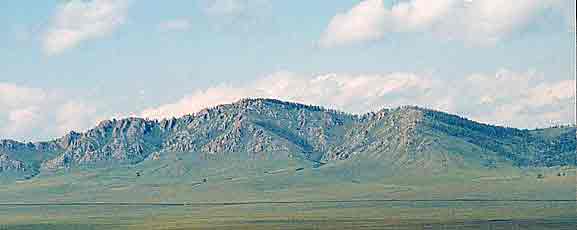
Khakassia: Valley of the dead
Khakassia
The name Khakass is of the Chinese origin and was used for an ancient tribe in the Sayan Mountains (Mount Karagosh 2'930 m).The appearance and habits of this "Kirgiz" people were described in the Chinese chronicles in the first centuries AD approximately. The Khakass themselves have been using their own tribal designation (Sagai, Khas, Beltir, Shor, Koibal, Kyzyl).
Nowadays, the Khakass live in Siberia on the Upper Enisey River. The northern and the eastern parts of the region are flat steppe land (the Abakan-Minusinsk-Basin) while the southern and western parts are mountainous (the Sayan and Altai mountains). Neighbouring the Khakass territory are the Kemerovo Region, the Krasnoyarsk Province, the Republics Altai and Tuva. The name of the capital is Abakan which means the 'bear's blood'. The area is one and a half times bigger than Switzerland with a population of about half a million people.
Abakan, the capital of the Republic of Khakassia (founded in 1930) has its origins in the fortress of Abakan built in 1707. Legend tells of the Khakassian commander whose name means 'Bear’s Blood'. He jumped into the river, and thus gave the river and city his name.
The Khakass language belongs to the Uighur-Oguz group in the eastern Hun branch of the Turkic language, and is an aggregation of different tribal languages (dialects). The Sagai and the Kachin dialects are the most widespread dialects of today.
A Chinese chronicle, Tan-shu (618-907), mentions a written language of the Enisey Kirgiz tribes, Turkic script, comparing it with the written language of the Oirots (the biggest tribe in the High Altai "Gorno-Altaisk" - old name: "Ulala"). By the seventh-eighth centuries AD at the latest, the ancestors of the Khakass were using an old Turkic script; by the fourteenth century, however, this practice had ceased. In the seventeenth century the Kalmyk written language was used to communicate with the Russians.
History
As early as in the Paleolithic period the region of present-day Khakassia was populated by pastoral nomads, hunters and fishermen. The rulers changed (the Huns, the Zhuzhans, the Altai Turks or "Oirats"), people wandered and the borders shifted. Since the 6th century the influence of the Altaic and Uighur tribes has strengthened the Turkic ethnic element. During this period, ancient Kirgiz tribes arose, and a little later (8th till 9th centuries) the Enisey Kirgiz tribes, the far ancestors of the Khakass emerged.
In 1207 the region was conquered by Genghis Khan, and his successors in their turn increased their domains into China. In 1368 the Mongols were overthrown, and there followed a constant struggle for power (the Oirats, Yesenya Khan, Altyn Khan). At the beginning of the 17th century the Russians arrived and gradually gained control of the region by the Cossacks. The nomads were unable to put up a unified fight against the Russians and they were each defeated in turn (the Arinis in 1608, the Sagais in 1620 etc.). In 1708 the areas of the Enisey Kirgiz tribes were incorporated into the Russian Empire.
- More information on the history of the people from the Altai and the Altai region you can look up in Nohon's first two albums: Üch-Sümer - FM 50018 and Altai-Maktal - FM 50020.
- watch profile YouTube
Revised by Chagat Almashev
and Silvia Delorenzi-Schenkel
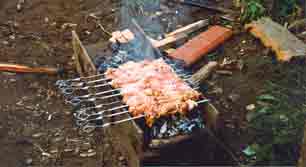 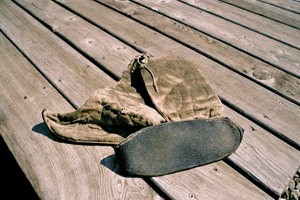
Khakassia: sheep-shashlik - boots
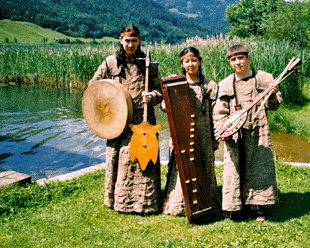
Erturk Jety-Sary, Toma Tchousteyeva, Emil Terkish
|
